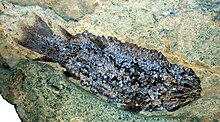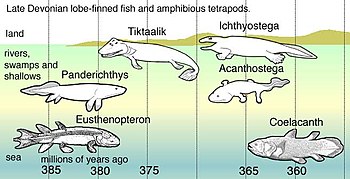Eusthenopteron: Difference between revisions
m clean up- spelling "et al." and gen fixes using AWB |
No edit summary |
||
| Line 47: | Line 47: | ||
==In popular culture== |
==In popular culture== |
||
* ''Eusthenopteron'' was featured in the second episode of [[Animal Armageddon]]. |
* ''Eusthenopteron'' was featured in the second episode of [[Animal Armageddon]]. |
||
*''Eusthenopteron'' has also been widely featured in textbooks as a 'missing link' between fish and tetrapods. |
|||
==See also== |
==See also== |
||
{{portal|Paleontology}} |
{{portal|Paleontology}} |
||
Revision as of 23:52, 15 June 2009
| Eusthenopteron Temporal range: Late Devonian
| |
|---|---|

| |
| life restoration of Eusthenopteron foordi | |
| Scientific classification | |
| Kingdom: | |
| Phylum: | |
| Subphylum: | |
| Class: | |
| Subclass: | |
| Superorder: | |
| Family: | |
| Genus: | Eusthenopteron Whiteaves, 1881
|
| Species | |
| |
Eusthenopteron is a genus of prehistoric lobe-finned fish which has attained an iconic status from its close relationships to tetrapods. Early depictions of this animal show it emerging onto land, however paleontologists now widely agree that it was a pelagic animal. The genus Eusthenopteron is known from several species that lived during the Late Devonian period, about 385 million years ago. Eusthenopteron was first described by J. F. Whiteaves in 1881, as part of a large collection of fishes from Miguasha, Quebec. Some 2,000 Eusthenopteron specimens have been collected from Miguasha, one of which was the object of intensely detailed study and several papers from the 1940s to the 1990s by paleoichthyologist Erik Jarvik[1].
Description

Anatomically, Eusthenopteron shares many unique features in common with the earliest known tetrapods. It shares a similar pattern of skull rooting bones with forms such as Ichthyostega and Acanthostega. Eusthenopteron, like other tetrapodomorph fishes, had internal nostrils, (or a choana) which are found only in land animals and sarcopterygians. It also had labyrinthodont teeth, characterized by infolded enamel, which characterizes all of the earliest known tetrapods as well. Like other basal sarcopterygians, Eusthenopteron possessed a two-part cranium, which hinged at mid-length along an intracranial joint. Eusthenopteron's notoriety comes from the pattern of its fin endoskeleton, which bears a distinct humerus, ulna, and radius (in the fore-fin) and femur, tibia, and fibula (in the pelvic fin). This is the characteristic pattern seen in tetrapods. It is now known to be a general character of fossil sarcopterygian fins.

- Panderichthys, suited to muddy shallows;
- Tiktaalik with limb-like fins that could take it onto land;
- Early tetrapods in weed-filled swamps, such as:
- Acanthostega which had feet with eight digits,
- Ichthyostega with limbs.
Eusthenopteron differs significantly from later Carboniferous tetrapods in the apparent absence of a recognized larval stage and a definitive metamorphosis. In even the smallest known specimen of Eusthenopteron foordi (at 29 mm), the lepidotrichia cover all of the fins, which does not happen until after metamorphosis in genera like Polyodon. This might indicate that Eusthenopteron developed directly, with the hatchling already attaining the general body form of the adult (Cote et al., 2002).
In popular culture
- Eusthenopteron was featured in the second episode of Animal Armageddon.
- Eusthenopteron has also been widely featured in textbooks as a 'missing link' between fish and tetrapods.
See also
References
- ^ Geological Survey of Canada (2008-02-07). "Past lives: Chronicles of Canadian Paleontology: Eusthenopteron - the Prince of Miguasha". Retrieved 2009-02-10.
- S. Cote, R. Carroll, R. Cloutier, and L. Bar-Sagi (2002). "Vertebral development in the Devonian Sarcopterygian fish Eusthenopteron foordi and the polarity of vertebral evolution in non-amniote tetrapods". Journal of Vertebrate Paleontology. 22 (3): 487–502. doi:10.1671/0272-4634(2002)022[0487:VDITDS]2.0.CO;2.
{{cite journal}}: Unknown parameter|month=ignored (help)CS1 maint: multiple names: authors list (link)
- R. Cloutier (1996). "Taxonomic review of Eusthenopteron foordi.". Devonian Fishes and Plants of Miguasha, Quebec, Canada. Dr. Friedrich Pfeil, München. pp. 487–502.
- E. Jarvik (1980). Basic Structure and Evolution of Vertebrates. Academic Pess.






